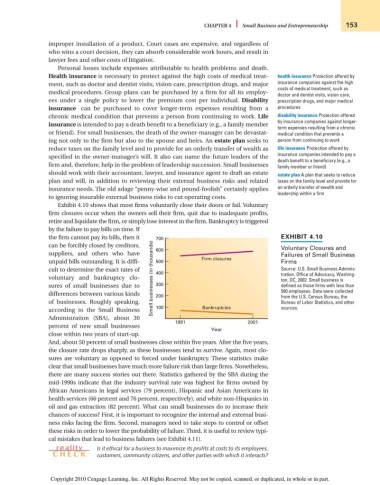Page 179 - Introduction to Business
P. 179
CHAPTER 4 Small Business and Entrepreneurship 153
improper installation of a product. Court cases are expensive, and regardless of
who wins a court decision, they can absorb considerable work hours, and result in
lawyer fees and other costs of litigation.
Personal losses include expenses attributable to health problems and death.
Health insurance is necessary to protect against the high costs of medical treat- health insurance Protection offered by
ment, such as doctor and dentist visits, vision care, prescription drugs, and major insurance companies against the high
costs of medical treatment, such as
medical procedures. Group plans can be purchased by a firm for all its employ- doctor and dentist visits, vision care,
ees under a single policy to lower the premium cost per individual. Disability prescription drugs, and major medical
insurance can be purchased to cover longer-term expenses resulting from a procedures
chronic medical condition that prevents a person from continuing to work. Life disability insurance Protection offered
by insurance companies against longer-
insurance is intended to pay a death benefit to a beneficiary (e.g., a family member
term expenses resulting from a chronic
or friend). For small businesses, the death of the owner-manager can be devastat- medical condition that prevents a
ing not only to the firm but also to the spouse and heirs. An estate plan seeks to person from continuing to work
reduce taxes on the family level and to provide for an orderly transfer of wealth as life insurance Protection offered by
specified in the owner-manager’s will. It also can name the future leaders of the insurance companies intended to pay a
death benefit to a beneficiary (e.g., a
firm and, therefore, help in the problem of leadership succession. Small businesses family member or friend)
should work with their accountant, lawyer, and insurance agent to draft an estate estate plan A plan that seeks to reduce
plan and will, in addition to reviewing their external business risks and related taxes on the family level and provide for
insurance needs. The old adage “penny-wise and pound-foolish” certainly applies an orderly transfer of wealth and
leadership within a firm
to ignoring insurable external business risks to cut operating costs.
Exhibit 4.10 shows that most firms voluntarily close their doors or fail. Voluntary
firm closures occur when the owners sell their firm, quit due to inadequate profits,
retire and liquidate the firm, or simply lose interest in the firm. Bankruptcy is triggered
by the failure to pay bills on time. If
the firm cannot pay its bills, then it 700 EXHIBIT 4.10
can be forcibly closed by creditors, Voluntary Closures and
suppliers, and others who have 600 Failures of Small Business
unpaid bills outstanding. It is diffi- (in thousands) 500 Firm closures Firms
cult to determine the exact rates of 400 Source: U.S. Small Business Adminis-
voluntary and bankruptcy clo- tration, Office of Advocacy, Washing-
ton, DC, 2002. Small business is
sures of small businesses due to businesses 300 defined as those firms with less than
differences between various kinds 200 500 employees. Data were collected
from the U.S. Census Bureau, the
of businesses. Roughly speaking, Bureau of Labor Statistics, and other
according to the Small Business Small 100 Bankruptcies sources.
Administration (SBA), about 30
1991 2001
percent of new small businesses
Year
close within two years of start-up.
And, about 50 percent of small businesses close within five years. After the five years,
the closure rate drops sharply, as these businesses tend to survive. Again, most clo-
sures are voluntary as opposed to forced under bankruptcy. These statistics make
clear that small businesses have much more failure risk than large firms. Nonetheless,
there are many success stories out there. Statistics gathered by the SBA during the
mid-1990s indicate that the industry survival rate was highest for firms owned by
African Americans in legal services (79 percent), Hispanic and Asian Americans in
health services (66 percent and 76 percent, respectively), and white non-Hispanics in
oil and gas extraction (82 percent). What can small businesses do to increase their
chances of success? First, it is important to recognize the internal and external busi-
ness risks facing the firm. Second, managers need to take steps to control or offset
these risks in order to lower the probability of failure. Third, it is useful to review typi-
cal mistakes that lead to business failures (see Exhibit 4.11).
reality Is it ethical for a business to maximize its profits at costs to its employees,
CH ECK customers, community citizens, and other parties with which it interacts?
Copyright 2010 Cengage Learning, Inc. All Rights Reserved. May not be copied, scanned, or duplicated, in whole or in part.

